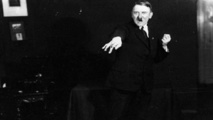But Deputy Chancellor Reinhold Mitterlehner said that the building near the German border has heritage protection and so "cannot be demolished".
He said it could be used "for educational purposes" such as a museum.
Sobotka said though that the building was "not worthy" of such a status since it was bestowed by the Nazis after Hitler annexed his native country into the Third Reich in 1938.
The legislation, still to be approved by parliament, would see the owner, whose family has been in possession of the house for more than century, forcibly dispossessed after years of fruitless talks.
The aim of the government, which announced its intention to seize the house in April, is to stop the building become a shrine for neo-Nazis. A 12-person commission is currently examining the different options.
Gerhard Baumgartner, head of the Austrian Resistance Documentation Centre, said that the building should be "completely depoliticised" to stop what he said was the building's growing attraction among neo-Nazis.
"We are seeing that a kind of European tourism. Last year there was a bus trip from Hungary visiting, this year different prominent far-right figures stopped on their way through," Baumgartner told Oe1 public radio.
"It should be turned into something that nobody wants to be photographed in front of... a supermarket, a Humana (second-hand clothes shop) or a fire station -- a sensible usage."
The house is an unremarkable three-storey yellow-painted building in the centre of a quaint and quiet town.
But local historians say Hitler, who came into the world in 1889, was not born in the house itself but in a building behind it that has long since been demolished. His family moved away from Braunau when Hitler was three.
Outside there is a stone memorial that reads: "For Peace, Freedom and Democracy. Never Again Fascism, Millions of Dead Warn."
-----------------------------------------------------------------------------------------------------------------------
He said it could be used "for educational purposes" such as a museum.
Sobotka said though that the building was "not worthy" of such a status since it was bestowed by the Nazis after Hitler annexed his native country into the Third Reich in 1938.
The legislation, still to be approved by parliament, would see the owner, whose family has been in possession of the house for more than century, forcibly dispossessed after years of fruitless talks.
The aim of the government, which announced its intention to seize the house in April, is to stop the building become a shrine for neo-Nazis. A 12-person commission is currently examining the different options.
Gerhard Baumgartner, head of the Austrian Resistance Documentation Centre, said that the building should be "completely depoliticised" to stop what he said was the building's growing attraction among neo-Nazis.
"We are seeing that a kind of European tourism. Last year there was a bus trip from Hungary visiting, this year different prominent far-right figures stopped on their way through," Baumgartner told Oe1 public radio.
"It should be turned into something that nobody wants to be photographed in front of... a supermarket, a Humana (second-hand clothes shop) or a fire station -- a sensible usage."
The house is an unremarkable three-storey yellow-painted building in the centre of a quaint and quiet town.
But local historians say Hitler, who came into the world in 1889, was not born in the house itself but in a building behind it that has long since been demolished. His family moved away from Braunau when Hitler was three.
Outside there is a stone memorial that reads: "For Peace, Freedom and Democracy. Never Again Fascism, Millions of Dead Warn."
-----------------------------------------------------------------------------------------------------------------------









 Home
Home Politics
Politics











